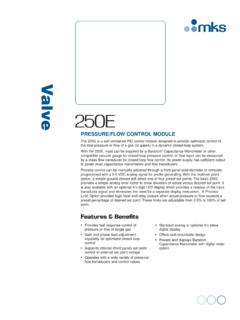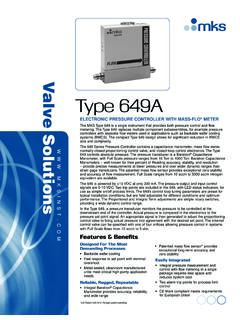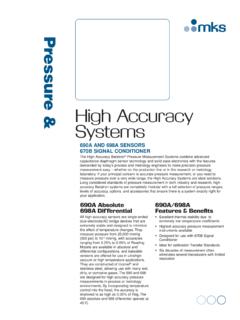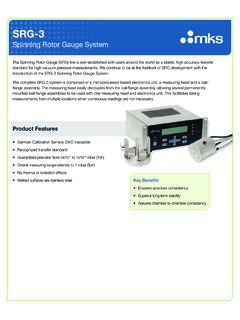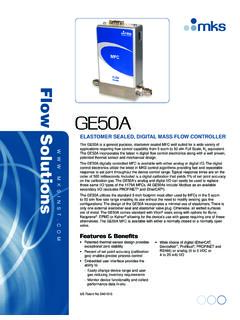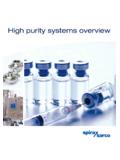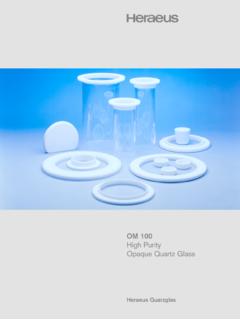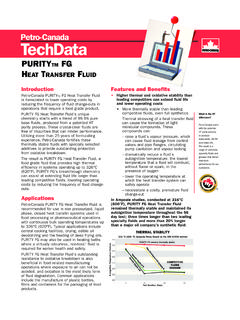Transcription of Hydrogen Purity Analysis by FTIR - MKS Instruments
1 Application Note Hydrogen Purity Analysis by ftir . PROBLEM. Historically, Hydrogen has been employed in a variety normal, resulting in improved engine efficiency and greatly of industrial chemical processes. Typically, the Purity reduced emissions, especially NOx. Mixtures containing more requirements for this Hydrogen have tolerated contaminant than 30% Hydrogen can also be used as fuel in ICEs, but the levels ranging from ppm to low percentages, depending upon engines must be specially adapted. the application. The use of Hydrogen has now expanded into novel applications such as alternative fuel for use in Alternatively, the chemical energy in Hydrogen may be transportation and stationary electrical generation.
2 These converted to electrical energy through an electrochemical applications demand Hydrogen Purity levels which place severe reaction in a PEM (Polymer Electrolyte Membrane) fuel cell demands on the analytical instrumentation employed for gas (Figure 1). The fuel cell reaction is essentially the reverse of quality assurance. Thus the development of analytical tools electrolysis, generating electricity through the reaction between and methods that can simultaneously and accurately detect Hydrogen and oxygen to produce water and useable electricity: low levels of multiple contaminants is of critical importance 2H2 4H+ + 4e- to the implementation of the new energy technologies for transportation and energy generation.
3 O2 + 4H+ + 4e- 2H2O. BACKGROUND. Hydrogen is produced in the petrochemical and chemical industry using hydrocarbon reforming technology. The two main sources for industrial Hydrogen are steam reforming of methane (SMR) or other hydrocarbons, and the purified byproduct Hydrogen from naptha reformers, chlorine gas production and other chemical processes. The direct production of Hydrogen by electrolysis, a source of Hydrogen not based on hydrocarbons, is of obvious interest, however it accounts for less than of world Hydrogen supplies. Traditionally, Hydrogen has been viewed as an important chemical reactant, particularly for the hydrocarbon cracking processes used in the petrochemical industries.
4 More Figure 1 - PEM Fuel Cell recently, as the price volatility of fossil fuel has increased and as concerns over anthropogenic greenhouse gases have heightened, the use of Hydrogen as an alternate energy source Platinum (Pt) catalyst particles on a porous carbon anode to fossil fuels has gained tremendous interest, especially for dissociate Hydrogen molecules to protons and electrons. The applications such as transportation and electricity generation. electrons pass through the external circuit while the protons diffuse through the PEM to the cathode, combining with the Hydrogen can be converted to energy in two very different electrons and oxygen from air to produce water.
5 Ways. Its chemical potential energy can be directly converted Pt catalysts are extremely sensitive to chemical poisoning to mechanical energy through combustion in an internal and very low contamination levels in the Hydrogen feed can combustion engine (ICE), either as a mixture with poison the catalyst, inducing non-recoverable losses in fuel hydrocarbon fuels or as the pure element. Mixtures of up cell performance (Figure 2). This places extreme demands on to 20% Hydrogen in natural gas, known as Hythane, can be the Purity of the Hydrogen used as fuel to the cell. Maximum used in engines adapted for burning natural gas without any allowable levels of certain contaminants are in the ppb range.
6 Further modifications to the engine. The presence of Hydrogen in the hydrocarbon allows a much leaner combustion than Page 2. Application Note SAE J2719. Potential Maximum Impurity Allowable Limits Components (ppmv). Ammonia Carbon Monoxide (CO) Carbon Dioxide Formaldehyde (H2CO) Formic Acid (HCOOH) Total Hydrocarbon (Reported as C1). Methane (CH4) Ethane (C2H6) Ethylene (C2H4) Figure 2 - Hydrogen impurity effects on a PEM fuel cell Propane (C3H8) Water (H2O) Depending upon the source of the Hydrogen , the impurities Table 1 - SAE 2719 Hydrogen Quality Guideline for Fuel Cell and their concentrations differ.
7 Steam reforming proceeds Vehicles according to the chemical reaction: hydrocarbons and water that can cause serious interferences in some analytical methods. Finally, the analytical data must CnH2n+2 + nH2O nCO + 2nH2. allow chemical speciation of the contaminants. For cost + effectiveness, these characteristics should be present in a single nCO + nH2O nCO2 + nH2 analyzer that can be used for on-line quality monitoring. for an overall stoichiometry of: SOLUTION. CnH2n+2 + H2O nCO2 + (2n+1)H2 CO, CO2, NH3, formaldehyde, H2O and hydrocarbons, The chemistry of steam reforming dictates that the primary methane, ethane, etc.
8 , are the contaminants of most contaminants in the Hydrogen product will derive from the importance for PEM fuel monitoring. As noted, analytical reactants ( CnH2n+2 and H2O) and byproducts (CO and methods for the detection of these contaminants must be CO2). Similarly, the chemistry of other chemical routes to capable of simultaneous and rapid detection of ppb levels in Hydrogen results in low levels of H2S, COS and nitrogen the presence of Hydrogen . ftir is an excellent tool for this compounds such as NH3 in the Hydrogen product, along with Analysis in that it can detect all of the contaminant species of residues of the reactants, hydrocarbon oxidation and other interest rapidly and simultaneously; it has detection limits in products.
9 Table 1 shows the current SAE 2719 guideline for the ppb regime; and it can tolerate analyte interferences. Hydrogen Purity in fuel cell applications. The MKS MultiGas 2031 and the MultiGas 2032 are low The sensitivity of PEM fuel cells to low levels of maintenance, low cost ftir analyzers that are an effective contamination means that real-time, on-line monitoring of solution for simultaneous multi-component analyses of Hydrogen quality is critical for efficient operation. Hydrogen contaminants in Hydrogen . They can be integrated as an on- quality monitors must be capable of fast and accurate multi- line Hydrogen quality monitor in a variety of configurations, component analyses for species at concentration ranges that including at the outlet of a reforming plant, as a monitor prior can vary from ppb to % level.
10 As well, the Analysis must to gas cylinder filling, and as a qualifier for Hydrogen from gas be accurate in the presence of % levels of species such as cylinders as well as on site at a fuel filling station. Page 3. Application Note ftir Method Validation Our ftir Method Validation was performed in accordance Blanks employed in the validation were purified H2 with with ASTM D7653-10 Standard Test Method for no detectable impurities in accordance with the Guideline. Determination of Trace Gaseous Contaminants in Hydrogen The first estimate of the method detection limit was 3. Fuel by Fourier Transform Infrared ( ftir ) Spectroscopy.
